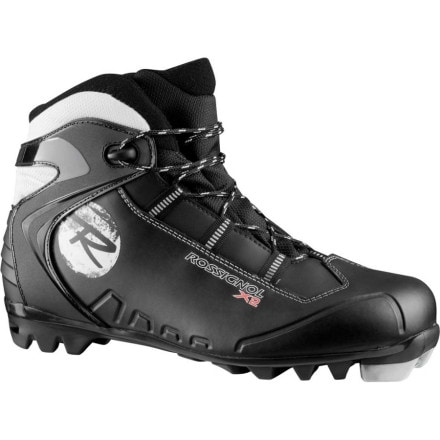In the previous post, I discussed the different clothes you'll need to start cross-country skiing.
In this post, I'll talk about the gear you'll need. This gear will allow you to ski fairly efficiently on local trails in powder or a ski-track or on a groomed trail. These are not the skis that you can make downhill turns with (although I hear some people do). Also, this is not the gear that will get you on the podium in any cross-country ski races. This is medium-grade gear that will get you out on the trails and break that cabin fever!
Skis: I like the Rossignol BC70 as a great all-purpose cross-country ski. It is about the widest ski that will fit into a groomed track, and it comes with metal edges for control on descents. Definitely get metal edges! And you'll also want to get the "scales" on the bottom that allow you to get some traction going uphill....you shouldn't need climbing skins for basic cross-country ski adventures; those are used for more advanced backcountry skiing.

Bindings: The bindings are a very important piece of the equation here. To increase the capability of your skis (but adding only a few dollars to the cost), you certainly want to get NNN-BC bindings. These bindings have a little bit thicker bar on them where you click-in your boots to the skis, thereby increasing your stability.
Boots: Boots are a very personal decision, and I don't want to send anyone in the wrong direction here by recommending a specific boot. Some of the things to look for in a boot are
1) Proper fit (no kidding, right?)
2) Zippers. Do you really want zippers that can freeze up or break? I don't like them, but others do.
3) Ankle stability. The pair of boots I got don't have a plastic strip on the ankle that can provide stability. I wish I had paid extra for that. Definitely consider the upgrade to a pair of boots that has a plastic stability strip around the ankle and a velcro strap across the shin.
4. Waterproofness. Consider that your feet will be sliding through snow for several hours, in contact with that snow against the warmth of your foot and boot....all that produces water. Water and cold and feet don't mix! Try to get a pair of boots that has really good waterproofing. Full plastic boots is probably overkill, though.
5. Eyelets. Like the zippers, lacing eyelets can break and freeze-up. I prefer a standard boot-lacing system over multiple laceing eyelets.
Poles: When you buy the skis, you can consider getting poles. You'll definitely need the poles. But...you might already have a pair for backpacking or whatever. The general-purpose trekking poles work just fine, but the powder baskets tend to get lost alot more than you might expect.....and the poles don't work without the powder basket. I think this is more of a financial decision than anything else if you already have trekking poles, but the default answer is to get the poles that come with the skis, especially if you are into a package deal.
Backpack: I'm assuming you want to get out and ski local trails and not in a resort area. You'll definitely need a backpack to carry assorted items. For starters, you'll NEED the TEN ESSENTIALS of being outdoors. I recommend you also carry those extra gloves and socks I mentioned in the clothes post the other day. I sometimes take a small camp stove and hot chocolate mix if I'm with a crew that is more about experience than the workout...or I'm taking my kids out for the day(!). ALWAYS PACK A HEADLAMP for the same reasons that you pack the heavy socks and gloves. The backpack should have a place for a water bladder, of course. I recommend that it have a flap or stash-pocket on the outside to secure layers on the outside of the pack (putting them inside the pack takes time and gets all the inside-stuff wet).
Finally, as far as food and such goes, take the same stuff you would take on a long bike ride and then add some good "fillers" like cookies...hey, this is supposed to be fun!



No comments:
Post a Comment